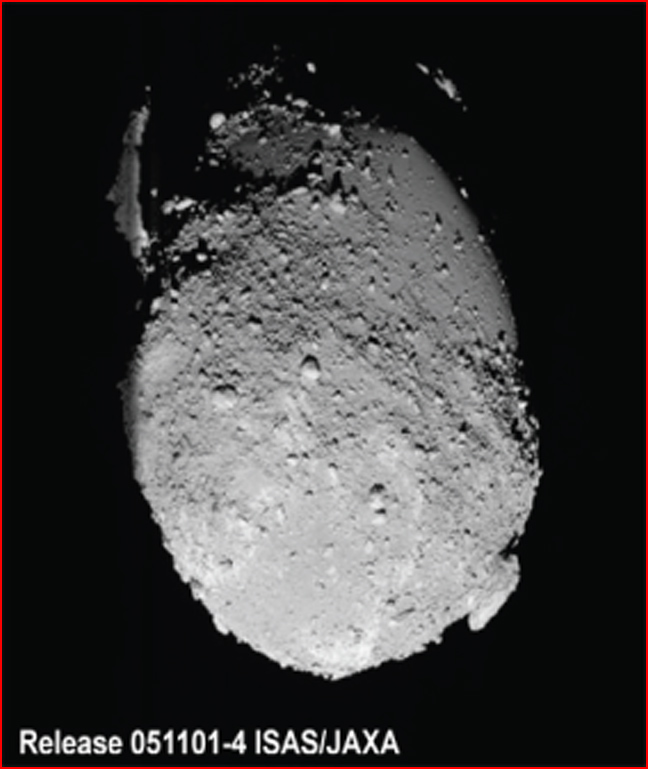
home •
about •
essential guide •
picture of the day •
thunderblogs •
news •
multimedia •
predictions •
products •
get involved •
contact
picture of the day archive subject index
Sorted banding of surface materials on Itokawa. Credit: Japan Aerospace Exploration Agency (JAXA)
Apr 29, 2008
Particle Sorting on Asteroid Itokawa
Scientists report that impact vibrations are causing rocks and gravel on the surface to sort themselves by size. But is the mechanical vibration theory correct?
On May 9, 2003, the Japanese space probe, Hayabusa, was launched from the Kagoshima launch facility toward the asteroid, 25143 Itokawa. Its planned mission was to land on the surface of the asteroid and return to Earth with a sample of the soil. The spacecraft did land on the asteroid, but due to some instrument malfunction, it was twice unable to gather samples. Despite the loss of telemetry from the spacecraft, however, Hayabusa did manage to take off and begin its return journey to Earth, due to arrive in 2010.Recent findings by a team of researchers from the University of Tokyo and the Arizona-based Planetary Science Institute announced that "regolith migration and sorting" is occurring on Itokawa. In close up images of the asteroid, the materials are aligned and segregated, with larger rocks sitting on top of smaller gravels. The stones and pebbles appear to congregate in bands along the surface as well, leaving some areas with a finer composition and others with an accumulation of larger fragments.
As the asteroidsand cometslive their lives within the electric currents that pass between the stars, they exhibit similar formations and overall topography. As we have written in past Picture of the Day articles, some have craters so large that, if formed by impact, it is a mystery why they were not blown to pieces. There are also gouges and groves and parallel cliffs that defy conventional explanation.
The proposed mechanism for the granule separation effect is vibration from the impact of small meteors. The vibrations cause the granules to segregate from the shaking and form layers, with the heavier material on top, gradually decreasing in diameter and density toward the bottom and sides. Just as the raisins will rise to the top of a box of raisin bran when you shake it, the larger objects within Itokawa's loose surface deposits supposedly rise to the top from the repeated shocks.
A previous Thunderbolts Picture of the Day analyzed images from the Hayabusa spacecraft's high-resolution cameras and described the electrical nature of the asteroid's surface. Itokawa's makeup surprised the investigators, because it is far less dense than was expected. From the perspective of an Electric Universe model, however, the debris that characterizes many asteroids and comets can be easily explained.
Electrical sorting could be taking place on Itokawa - very much like the sorting of Saturn's rings into thousands of bands. Small rock particles can float on an ionic 'wind' that moves them away from the area of strongest plasma flux density, so some areas of the asteroid are covered with fine particles. Larger pebbles and gravel could also be dragged along due to the conductive material in them and form debris fields that are perpendicular to the electric charges.
Because many common materials also possess "semi-conductor" properties (silicon dioxide, for example), magnetic fields will attract them differently. Therefore, because of variations in electrical resistivity, it appears as if the granules on Itokawa's surface are being sorted by their ability to carry electric charges.
By Stephen Smith
___________________________________________________________________________Please visit our Forum
The Electric Sky and The Electric Universe available now!

|
|

|
EXECUTIVE EDITORS:
David Talbott, Wallace Thornhill
MANAGING EDITORS:
Steve Smith, Mel Acheson
CONTRIBUTING EDITORS: Michael Armstrong, Dwardu Cardona,
Ev Cochrane,
C.J. Ransom, Don Scott, Rens van der Sluijs, Ian Tresman
WEBMASTER: Brian Talbott
Copyright 2008: thunderbolts.info
![]()
home •
thunderblogs •
forum •
picture of the day •
resources •
team •
updates •
contact us

